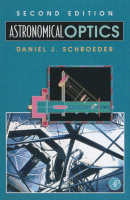Browse content
Table of contents
Actions for selected chapters
- Full text access
- Book chapterNo access
Chapter 1 - Introduction
Pages 1-6 - Book chapterNo access
Chapter 2 - Preliminaries: Definitions and Paraxial Optics
Pages 7-26 - Book chapterNo access
Chapter 3 - Fermat's Principle: An Introduction
Pages 27-47 - Book chapterNo access
Chapter 4 - Introduction to Aberrations
Pages 48-69 - Book chapterNo access
Chapter 5 - Fermat's Principle and Aberrations
Pages 70-111 - Book chapterNo access
Chapter 6 - Reflecting Telescopes
Pages 112-163 - Book chapterNo access
Chapter 7 - Schmidt Telescopes and Cameras
Pages 164-184 - Book chapterNo access
Chapter 8 - Catadioptric Telescopes and Cameras
Pages 185-205 - Book chapterNo access
Chapter 9 - Auxiliary Optics for Telescopes
Pages 206-239 - Book chapterNo access
Chapter 10 - Diffraction Theory and Aberrations
Pages 240-276 - Book chapterNo access
Chapter 11 - Transfer Functions; Hubble Space Telescope
Pages 277-303 - Book chapterNo access
Chapter 12 - Spectrometry: Definitions and Basic Principles
Pages 304-320 - Book chapterNo access
Chapter 13 - Dispersing Elements and Systems
Pages 321-351 - Book chapterNo access
Chapter 14 - Grating Aberrations; Concave Grating Spectrometers
Pages 352-367 - Book chapterNo access
Chapter 15 - Plane Grating Spectrometers
Pages 368-408 - Book chapterNo access
Chapter 16 - Adaptive Optics: An Introduction
Pages 409-424 - Book chapterNo access
Chapter 17 - Detectors, Signal-to-Noise, and Detection Limits
Pages 425-443 - Book chapterNo access
Chapter 18 - Large Mirrors and Telescope Arrays
Pages 444-458 - Book chapterNo access
Table of Symbols
Pages 459-465 - Book chapterNo access
Index
Pages 467-478
About the book
Description
This book provides a unified treatment of the characteristics of telescopes of all types, both those whose performance is set by geometrical aberrations and the effect of the atmosphere, and those diffraction-limited telescopes designed for observations from above the atmosphere. The emphasis throughout is on basic principles, such as Fermat's principle, and their application to optical systems specifically designed to image distant celestial sources.
The book also contains thorough discussions of the principles underlying all spectroscopic instrumentation, with special emphasis on grating instruments used with telescopes. An introduction to adaptive optics provides the needed background for further inquiry into this rapidly developing area.
This book provides a unified treatment of the characteristics of telescopes of all types, both those whose performance is set by geometrical aberrations and the effect of the atmosphere, and those diffraction-limited telescopes designed for observations from above the atmosphere. The emphasis throughout is on basic principles, such as Fermat's principle, and their application to optical systems specifically designed to image distant celestial sources.
The book also contains thorough discussions of the principles underlying all spectroscopic instrumentation, with special emphasis on grating instruments used with telescopes. An introduction to adaptive optics provides the needed background for further inquiry into this rapidly developing area.
Key Features
- Geometrical aberration theory based on Fermat's principle
- Diffraction theory and transfer function approach to near-perfect telescopes
- Thorough discussion of 2-mirror telescopes, including misalignments
- Basic principles of spectrometry; grating and echelle instruments
- Schmidt and other catadioptric telescopes
- Principles of adaptive optics
- Over 220 figures and nearly 90 summary tables
- Geometrical aberration theory based on Fermat's principle
- Diffraction theory and transfer function approach to near-perfect telescopes
- Thorough discussion of 2-mirror telescopes, including misalignments
- Basic principles of spectrometry; grating and echelle instruments
- Schmidt and other catadioptric telescopes
- Principles of adaptive optics
- Over 220 figures and nearly 90 summary tables
Details
ISBN
978-0-12-629810-9
Language
English
Published
2000
Copyright
Copyright © 2000 Elsevier Inc. All rights reserved
Imprint
Academic Press
